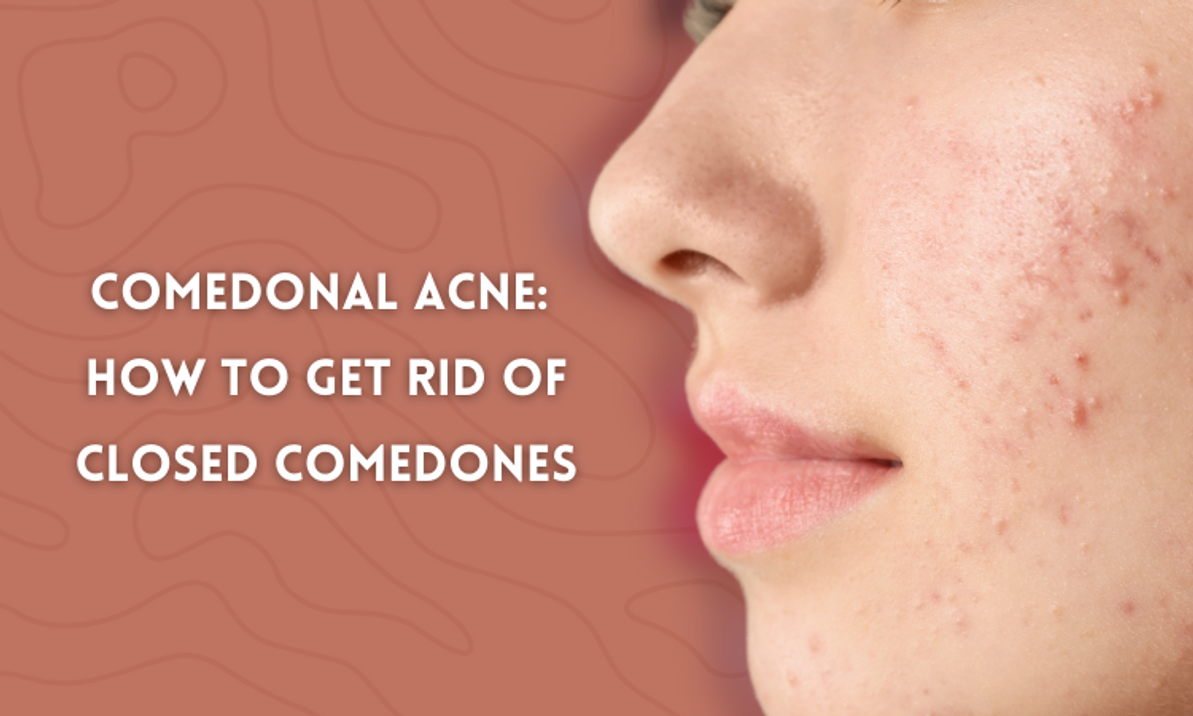Comedonal Acne: How to Get Rid of Closed Comedones
Comedonal Acne: How to Get Rid of Closed Comedones
So, you've seen more white or skin-colored bumps along your cheeks, forehead, and chin. You've tried almost everything to get rid of them, and they won't go away! Is it keratosis pilaris? An allergic reaction to a skin care product?
Well, surprise! It might be comedonal acne, otherwise known as closed comedones.
What is Comedonal Acne?
Comedonal acne is non-inflammatory, although it is considered the preliminary form of acne. This means if it is not taken care of, it can result in bigger, more inflamed breakouts or inflammatory acne.
When the hair follicle and pore are clogged, it becomes a clogged hair follicle and can form small bumps. These bumps can be filled with dead cells, bacteria, and excess oil. They are separated into two categories, open comedones, and closed comedones.
What are closed comedones? (Whiteheads)
Whiteheads (closed comedones) occur when the follicle is blocked by sebum, dead skin, and bacteria resulting in white or skin-colored bumps. These bumps are known as closed comedones and look like teeny-tiny whiteheads.
What we commonly refer to as whiteheads are pustules, as they are filled with pus, even though they have a white tip. Closed comedones (whiteheads) are NOT filled with pus and may be slightly hard to the touch, but can still appear white in color.
What are open comedones? (Blackheads)
Open comedones are what we call blackheads. This occurs when the blockage in the follicle is exposed to air; it turns black. Open comedones are also very common and can be treated with topical treatments like salicylic acid serums or a topical treatment containing azelaic acid.
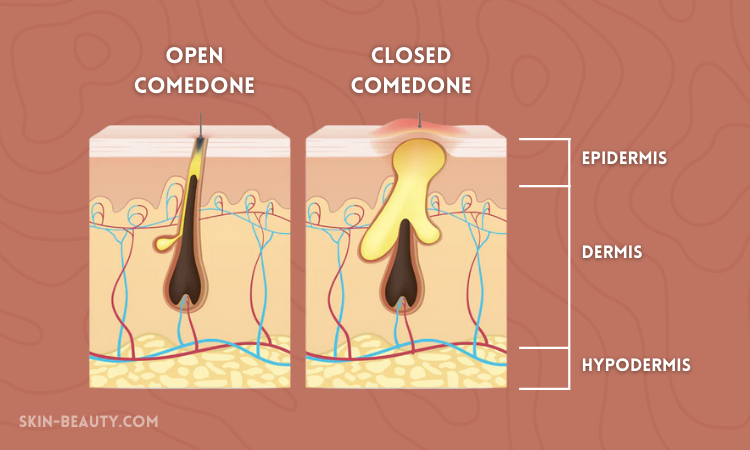
What causes closed comedones and comedonal acne?
Comedones form when the pore becomes clogged with sebum and dead skin cells. So, how do clogged hair follicles happen?
Some reasons for clogged pores include:
- Hormonal changes
- Stress
- Diet
- Hygiene
- Damage caused by using abrasive/harsh skincare products
Comedonal acne is commonly seen on the face in areas where there is a large amount of oil production. This can also include your back and chest area. Breakouts like these (on the body) typically heal slowly and will disappear on their own.
Products that are too rich in fatty oils or occlusives may also be the culprit of comedonal acne. Sometimes, although your skin looks great, the ingredients in some products don't work well for you. This also applies to other skin care treatments (like exfoliants) because another culprit of closed comedones can be over-exfoliating. Drying out the skin too much can also exacerbate already existing breakouts.
Comedonal acne is non-inflammatory and often appears with other types of acne like inflamed and hormonal acne or other inflamed acne.
Closed comedones on chin
Closed comedones (whiteheads) on the chin are very common, and although each skin type is different, chances are if you suffer from comedonal acne on your chin, it can be due to hormonal changes.
As your hormone levels change (progesterone and testosterone), your sebaceous glands can produce more or less oil. Excess oil levels can make your hair follicles more likely to get plugged up, resulting in closed comedones.
Closed comedones on forehead
Closed comedones (whiteheads) on the forehead are also very common. But there may be good news! Sweat and hair products like shampoo and conditioner can be some reasons why you have closed comedones.
A quick fix would be to switch out your products and wait to see if the bumps clear up. If they are still there, they may be closed comedones, and you may need topical treatments (benzoyl peroxide, salicylic acid, retinol, etc.) to get rid of them. If you have bangs then there might be excess oil production which can also cause whiteheads, also called comedones.
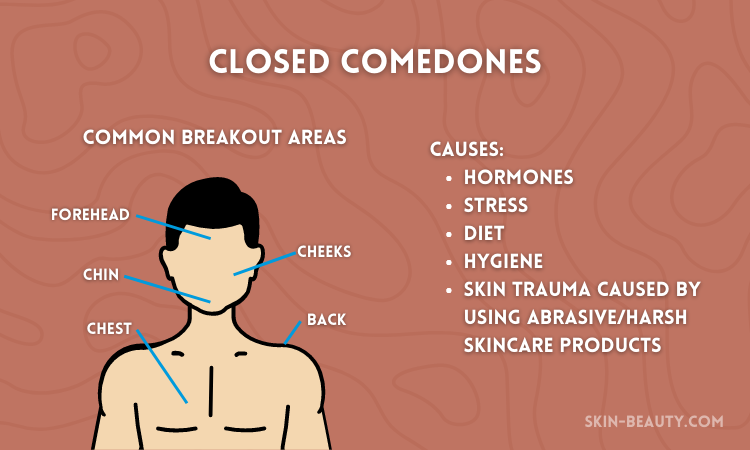
How to get rid of closed comedones
The most effective way to treat closed comedones (whiteheads) is to keep the pores clear of sebum (oil and skin cells) buildup while increasing skin health.
Some treatment options include:
1. Use gentle exfoliants like AHAs (alpha hydroxy acids) or BHAs (Beta hydroxy acids).
Incorporate products that contain AHA's or BHA's. This helps chemically exfoliate the skin without having to use harsh scrubs. Topical treatments with alpha hydroxy acids (AHAs) include ingredients like glycolic acid, mandelic acid, and lactic acid.
2. Use retinoids in your routine to speed up cell turnover.
Retinoids speed up cell turnover, which causes your skin cells to shed more quickly. This prevents clogging of the pores and leaves you with smoother skin. If you use topical retinoids, gradually increase the amount, as it can aggravate the skin. Be sure to apply SPF daily, as they also increase your skin's sensitivity to the UV rays.
3. Use benzoyl peroxide or salicylic acid on breakouts.
Apply these ingredients directly on closed comedones (whiteheads). The salicylic acid penetrates deep inside the closed pore to clean out any dead skin or debris, while benzoyl peroxide keeps closed comedones from forming by killing bacteria.
4. Use non-comedogenic products.
Although your skin may be clear, some fatty oils and occlusives can clog your pores, causing whiteheads. Always conduct a test patch when testing new products.
5. Don't squeeze your bumps!
Unlike pustules or blackheads (which should be extracted by a professional), closed comedones (whiteheads) occur when a plug in the hair follicle causes a bump to form. This means that no matter how hard you squeeze, nothing will come out because it is under the skin.
The most effective way to treat closed comedones is to keep the pores clear of sebum buildup while increasing skin health. Using topical treatments with AHA's, BHA's, and retinol on the surface of the skin can help clear out the clogged pores. You can always speak with a dermatologist to figure out what treatments and skin care products will work best for you.
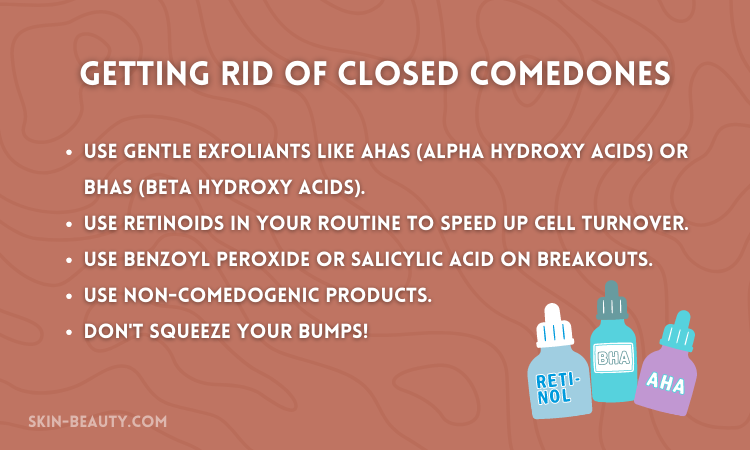
Niacinamide for closed comedones
Niacinamide can be a gentle exfoliating option for closed comedones (whiteheads). Try using a moisturizer with niacinamide so that your skin can stay hydrated and reduce the risk of clogging your pores. Niacinamide is also great for controlling excess sebum production, making it a great ingredient to add to your skin care routine.
Glycolic acid for closed comedones
Glycolic acid is the strongest of the alpha hydroxy acids (AHAs). However, it makes a great exfoliant that will help loosen the dead cells on the surface of the skin. You must test-patch your products first.
Mandelic acid for closed comedones
Mandelic acid is the most gentle AHA (alpha hydroxy acid). This could be an excellent option for sensitive skin types as it can help to exfoliate and help unclog pores. In addition, its anti-bacterial properties make it great for reducing acne-causing bacteria.
Lactic acid for closed comedones
Lactic acid is another gentle and effective AHA (alpha hydroxy acid) that loosens the "glue" that holds skin cells together. This loosens the dead skin cells on the surface, allowing the comedone to open and be cleared. Lactic acid also stimulates cell growth which can result in the improvement of the skin's overall appearance.
Retinol for closed comedones
Retinoids, derived from vitamin A, are the most effective in preventing and treating closed comedones (whiteheads). Various creams, serums, and face washes contain retinol, but anything containing retinoic acid or adapalene will require a prescription from your dermatologist, as these are over the counter medications.
Retinol is the ingredient most commonly found in off-the-shelf skincare products. Since retinoids are very potent, products that contain anywhere between .25% and .5% retinol are generally recommended and are a great starting point for anyone looking to incorporate retinol into their routine.
You can incorporate niacinamide into your routine to help reduce dryness and soothe your skin from the potential effects of retinol. Use lower percentages of retinol and niacinamide to let your skin adjust to the effects, and always remember to wear your SPF.
Natural remedies for closed comedones
If you are looking for something more natural to help with closed comedones, then you have some options.
Tea Tree Oil
Tea tree oil is a natural alternative to salicylic acid and benzoyl peroxide, which is why it is widely used in skincare products. Its antibacterial and antifungal properties make it an excellent option for treating comedones. Look for products containing tea tree oil or you can find various DIY skincare recipes online and create your own.
Witch Hazel
A natural astringent like witch hazel helps open up clogged pores and remove trapped dirt; it is a great natural way to treat comedones. It can also help reduce inflammation caused by excess sebum production on oily skin and remove dead skin cells. You can use this up to twice daily as part of your skincare routine - just make sure not to exceed use since too much can cause breakouts or skin irritation.
Charcoal or Clay
Charcoal and clay masks are great for people with comedonal acne because they help dry out trapped sebum in your pores. The abrasive particles can get rid of dirt, oil, and skin cells, making blackhead removal easier. It is a great way to combat excess oil, reducing the chance of clogging your pores.
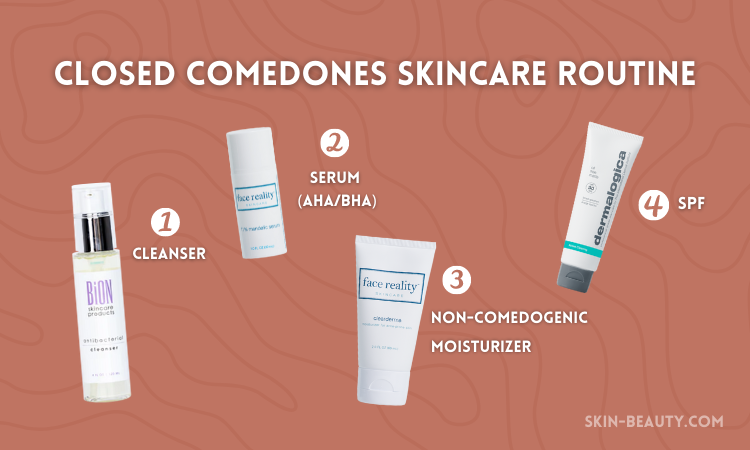
Closed comedones skin care routine
So we know what closed comedones (whiteheads) are, and now it's time to try to get rid of them. But with so many ingredients and so many product choices. How do you narrow it down? How do you pick the right products without using too many products?
Our biggest tip is? Keep it simple. Don't overwhelm your skin by using too many products with high concentrations of ingredients. Don't feel let down if you don't find the right products immediately. Finding the right combination for you takes time, as everyone is unique.
Your skincare routine may include:
- Gentle cleanser (with AHA/BHA)
- Serum (AHA or BHA based serum)
- Moisturizer
- SPF
Best products for closed comedones
Cleansers:
- BiON Antibacterial Cleanser
- Image Skincare Clear Cell Salicylic Gel Cleanser
- Epicuren Clarify Cleanser
Serums:
Retinol:
- PCA Skin Intensive Brightening Treatment: 0.5% Pure Retinol Night
- Dermalogica AGE Smart Overnight Retinol Repair 0.5%
- Le Mieux Retinol Serum
Moisturizers:
While comedonal acne can be annoying, it is the most accessible type of acne to combat with over the counter products. There are times when natural remedies and good routine will not be enough, and in severe cases, you may need a prescription strength topical treatment. Always consult your dermatologist or healthcare professional to determine what skincare or topical medications will work best for you.
Did we miss anything? Leave a comment below!
Recent Posts
-
The Power of Exosomes in Skincare
Exosomes in Skin Care: The Future of Exosome and Regenerative Medicine in Skin Science Skincare inn …Oct 17th 2025 -
Steps for a Skincare Routine
6 Steps to a Proper Skin Care Routine: Your Esthetician-Approved Guide to The Best Skin If you've ev …Aug 11th 2025 -
Treatment of Hyperpigmentation
How to Treat the Appearance of Hyperpigmentation This Summer: Your Complete Guide Summer sun is wond …Jul 17th 2025

